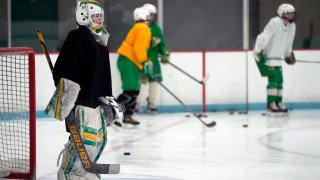
A day after professional hockey player Adam Johnson suffered a fatal cut to his throat during a game in England, Dan Sacco went out and ordered his 10-year-old twins new neck guards.
Colton and Harper Sacco play together as squirts — 9- and 10-year-olds — for the youth hockey program in North Branford, Connecticut. They already had neck guards, which are required for youth hockey in the state, but Sacco said he took another look at them after Johnson's death in October.
“They were small," he said. "So I got new ones that are made not to be sliced through and they're bigger. It's scary.”
Harper, a center, was not a big fan.
Get Connecticut local news, weather forecasts and entertainment stories to your inbox. Sign up for NBC Connecticut newsletters.
“At first I said it was a choking device, because it went up to here," she said, pointing to her chin. “But I got used to it.”
Johnson's death has renewed a national debate over whether there needs to be uniform standards and mandates for neck guards and other safety equipment when it comes to youth hockey.
USA Hockey, the nation's national governing body for the sport, recommends neck guards, but does not mandate them, leading to different policies — even within states.
Local
Dan Larochelle, a manager of the pro shop at the South Windsor Arena in Connecticut, said the guards he sells range in price from about $15 for a standard, relatively thin wrap-around guard, to $110 for hockey shirts made of cut-resistant material that come with thicker guards built in. Price, he said, can be a factor for many parents.
He said they have been selling a lot of neck guards since Johnson’s death, just as they did in 2022 when a Connecticut 16-year-old, Teddy Balkind, suffered a fatal cut to the throat. He was playing for a private prep school, St. Luke, in a league that did not require neck guards, even though the organization overseeing public youth hockey does.
Courtney Anderson was at home in Edina, Minnesota, when she read of Balkind’s death. Her 14-year old son, Evan Smolik, was a goalie on a bantam team in a league that did not require neck guards. She persuaded him to wear one.
A couple of weeks later, Evan was at practice when a teammate’s skate struck his throat. The cut hit his jugular vein, but the guard prevented it from cutting his carotid artery. Evan lost three pints of blood, but survived thanks to the guard and the quick work of a doctor at the rink and local paramedics, Anderson said.
Now 16, Evan is still playing and has persuaded his team to mandate neck guards.
“I feel like people mainly don’t wear neck guards because it’s not seen as cool or it looks dumb,” he said. “I never thought about it, until that kid got cut. But it made a huge difference for me. You wear it, and you won’t die.”
Former NHL player Pierre-Luc Létourneau-Leblond now coaches his 9-year-old son, Luc, for the Clifton Park (NY) Dynamos. He said wearing neck guards, whether mandated or not, needs to be normalized at every level, from the National Hockey League on down.
“If they all wear it, they’re not going to be worried about what they look like,” he said.
Any sort of mandate in the NHL would require an agreement between the league and players’ union, which have been discussing skate blade safety for years.
Last month, USA Hockey's board of directors voted to have its Safety and Protective Equipment Committee come up with wording for a mandate. Not long after, the International Ice Hockey Federation announced that it is making neck guards mandatory for the tournaments it runs, including the Olympics and men’s and women’s world championships.
In Canada, all boys and girls in hockey leagues and two top junior leagues are required to wear neck protection. The English Ice Hockey Association, which governs the sport below the Elite League where Johnson played, will require all players in England to wear neck guards beginning in 2024.
“The process will hopefully bring us closer to our ultimate goal, which has been my ultimate goal long before these tragedies, which is to develop high quality and affordable, cut resistant products, including neck laceration protectors, certify them, promote them, require them, make sure that you’re being manufactured, monitored, continuously evaluated and improved," said Dr. Michael Stuart, the chief medical officer for USA Hockey and head of the protective equipment committee. "And I think that’s a challenge for the entire hockey community.”
There are more than 387,000 youth hockey players in the U.S., according to USA Hockey data. Injury details can be hard to come by, but by one estimate, more than 12,000 of them seek emergency room care every year for injuries in practices or games; 7% of them seek aid for lacerations of some kind.
“The young kids is where a lot of this stuff happens because of the collisions that you see and some of the accidental falls,” said retired NHL defenseman Carlo Colaiacovo, whose 6-year-old son plays. “Every time he goes into a collision, I’m always watching those very closely because I’m thinking to myself: ‘OK, where are the skates? Where are the skates?’ It’s almost like a scar that has been created because I’ve seen it happen so much.”
Stuart said there also needs to be updated and higher standards when it comes to the effectiveness of the equipment designed to prevent cuts. He said a USA Hockey survey showed that 27% of neck lacerations occurred to players who were already wearing guards.
“Most are not actually tested or certified,” said Stuart, whose own son suffered a neck laceration in 1998. “Many do not even cover the most vulnerable anatomic areas.”
USA Hockey is working with the Hockey Equipment Certification Council, or HECC, to adopt new standards, and not just for neck guards, but for cut-resistant socks, wrist guards and protection for other vulnerable areas.
Some companies aren’t waiting for that.
Teri Weiss started her company, Skate Armor, 13 years ago after her then 9-year-old son, Mason Lohrei, took a stick blade to the throat and suffered a relatively minor cut. She said she tested Lohrei's neck guard and could cut through it easily with a kitchen knife. She saw a spike in orders after Balkind died and again after Johnson's death.
“It's been an uphill battle a lot of times,” she said. “Parents say, ‘Well, if they’re not mandating it, my kid doesn’t want to wear it.’
Her son is now 22 and has been up and down this season with the Boston Bruins in the NHL and the Providence Bruins in the AHL. He no longer wears a neck guard, much to his mom's dismay. He said it just doesn't fit well with his other equipment.
“Definitely I have rethought it [since Johnson's death],” he said. "I’ve actually been talking with her about it. I don’t wear a shirt under my stuff, so it’d be kind of weird to wear the shirt with that. So I’m trying to get her to make me something that, you know, looks like a shirt but isn’t necessarily. So maybe she’ll give me a custom piece because I’m her son."
AP Hockey Writer Stephen Whyno and AP Sports Writer Jimmy Golen contributed to this report.



